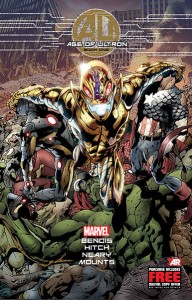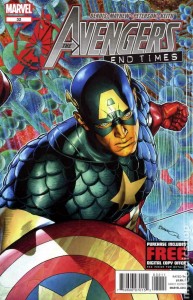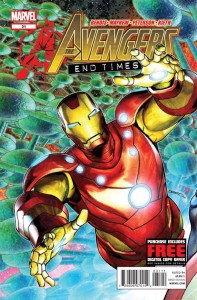We can’t bust heads like we used to, but we have our ways. One trick is to tell them stories that don’t go anywhere. Like the time I took the ferry to Shelbyville. I needed a new heel for my shoe so I decided to go to Morganville, which is what they called Shelbyville in those days. So I tied an onion to my belt, which was the style at the time. Now to take the ferry cost a nickel, and in those days, nickels had pictures of bumblebees on them. Give me five bees for a quarter you’d say. Now where were we? Oh yeah: the important thing was that I had an onion on my belt, which was the style at the time. They didn’t have white onions because of the war. The only thing you could get was those big yellow ones.
-Grandpa Simpson
What, exactly, is Age of Ultron about? This is a serious question.
We started out with a pretty straightforward end-of-the-world story with a bunch of killer robots that came literally out of nowhere and fucked up New York City. Then it was about infighting between superheroes, desperate last chances, and time travel. Okay, great. Now it’s about the Butterfly Effect, divergent timelines, and an alternate version of Marvel’s history where Hank Pym never existed, The Avengers broke up, and the world is under seige by Morgana Le Fey (“I toldja that Le Feys would be the end of America!” “Shut up, Dad!”). We’ve still got two issues left in Age of Ultron not counting crossover issues, which means we still have plenty of time for this series to tack in yet another direction, perhaps one about Friendship being Magic.
I’m not saying that Age of Ultron isn’t interesting; I was a rabid reader of What If? back when I was a kid, so I am a sucker for alternate versions of Marvel history, but I’m just not getting what writer Brian Michael Bendis is going for here. We’ve got a robot apocalypse that came out of left field, and that isn’t being addressed in other titles except in one-off “AU” issues that drop the character into the Ultron scenario for twenty pages before returning to the status quo in the next issue. And now, in issue 8, we are completely out of that apocalypse into an entirely different apocalypse that occurs when Hank Pym doesn’t exist – again, while none of this seems to be affecting the Marvel Universe as a whole. And all the while, we’ve got guys like Marvel Editor Tom Brevoort swearing that what happens in this book will have an effect on the greater 616, when it doesn’t seem to be having any effect right fucking now.
So what’s the endgame here? Is it to irrevokably change the nature of the Marvel Universe based on an apocalyptic event that led to some ill-advised time travel and cold-blooded murder? Is it to accentuate the importance of Ant Man to the Marvel Universe in time for the Edgar Wright movie in a couple of years? Is it to placate Bendis’s urge to apparently write the Marvel version of what might have happened if Arnold had blown Eddie Furlong out of his fucking socks the way we all wanted him to after two hours of bad acting in Terminator 2?
These are the questions I had when I finished Age of Ultron #8, a comic book that is cool if you like alternate versions of Marvel history, but which is yet another chapter of a story that seems to be bouncing from bad day to bad day without actually going anywhere in particular yet, and which, at this point in the story, just doesn’t feel like it matters.



 Podcast RSS Feed
Podcast RSS Feed iTunes
iTunes Google Play
Google Play Stitcher
Stitcher TuneIn Radio
TuneIn Radio Android
Android Miro Media Player
Miro Media Player Comics Podcast Network
Comics Podcast Network